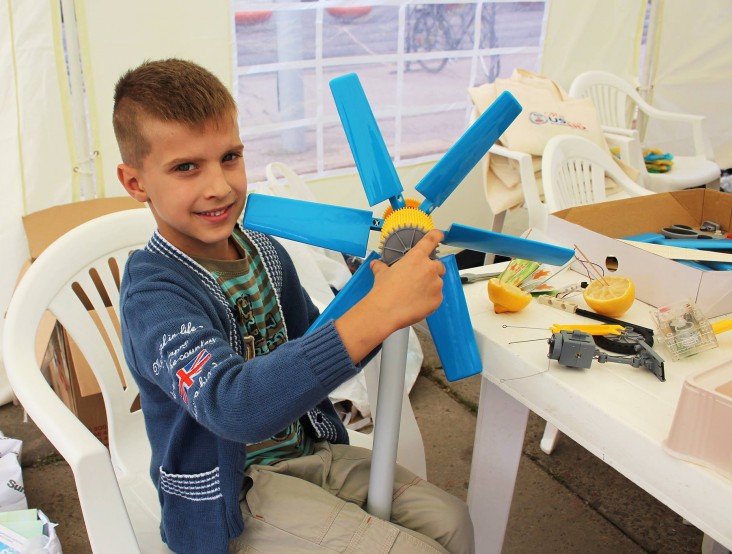
THE CHALLENGE:
Ukraine’s economy is one of the least energy efficient and most emission-intensive in the world. As a result, the country is a major contributor to global climate change. In order to produce a unit of its Gross Domestic Product (GDP), Ukraine emits more greenhouse gases (GHG) than almost any other country. Ukraine’s high GHG emissions are related to its energy intensity, which is over three times higher than the European Union average. Ukraine’s inefficient energy use impedes economic growth, leaves the economy highly vulnerable to price shifts, draws governmental and private sector resources away from other priority issues, and creates dependence upon foreign energy suppliers.
PROGRAM OBJECTIVE:
To enhance Ukraine’s energy security and reduce GHG emissions.
OVERVIEW:
USAID’s energy security program helps Ukraine improve the legal and regulatory environment and increase energy supply resilience. Currently USAID supports reform in Ukraine’s municipal sector, a large consumer of energy resources, by strengthening the legal, regulatory and institutional frameworks necessary to enable clean energy investment in Ukrainian cities. USAID also helps Ukraine initiate low emission development strategies to reduce Ukraine’s carbon footprint and enable sustainable development. In addition, USAID is supporting the establishment of competitive energy markets in electricity, natural gas, and district heating sectors and increasing renewable and indigenous energy supplies.
ONGOING PROGRAMS:
Municipal Energy Reform Project
The project goal is to reduce and mitigate greenhouse gas emissions in Ukraine resulting from the poor use of energy resources, which will lead to strengthened energy security and economic growth. The project 1) supports improvements in the clean energy regulatory and legislative enabling environment; 2) promotes investment in clean energy technologies and applications; 3) provides local capacity building training and raise awareness; and 4) enhances the Government of Ukraine’s capacity in low emission development strategies (EC LEDS).
Energy Sector Anticorruption & Fiscal Transparency Initiative In Ukraine (Transparent Energy)
The Energy Sector Anticorruption and Fiscal Transparency Initiative in Ukraine (Transparent Energy) is helping to combat corruption and improve fiscal transparency in Ukraine’s energy sector by instituting changes in the way the energy sector discloses, analyzes, and makes public information, which is now either hidden or restricted from public view. The project is vitally important in changing how stakeholders, including household consumers, journalists, and businesses, view the way in which the energy sector operates.
PROGRAM HIGHLIGHTS:
LEGISLATIVE/REGULATORY
- National Action Plan on Renewable Energy, National Action Plan on Energy Efficiency adopted and under implementation;
- Law on Home Owners Associations adopted; Regulatory acts for HOAs adopted and under implementation;
- Law on Information Disclosure for Tariffs adopted;
- Law on ESCO adopted; Regulatory acts for ESCO adopted and under implementation;
- Law on National Energy and Utility Regulatory Commission adopted;
- 8 decrees for district heating and district water sectors adopted by the NEURC;
- 6 million people obtained social subsidies during the 2015-2016 heating season to adapt to the new system.
TRAINING AND CAPACITY BUILDING
- Over 750 people, mostly staff of NEURC and regulated utilities, trained on regulatory issues;
- 3,088 Ministry of Social Policy staff (including regional offices) trained;
- 3,521 municipal professionals trained on efficient use of energy resources and municipal energy management;
- 324 journalists trained on clean energy issues;
- Over 170 people trained during LEDS development process, including state officials, academia, experts and civil society;
- Over 50 state and municipal officials, private and communal business, professional associations and civil society representatives trained in monitoring reporting and verification of GHG emissions.
SUSTAINIBLE ENERGY ACTION PLANS (SEAP)
- 15 partner cities developed Sustainable Energy Action Plans (SEAPs);
- 9 SEAPs approved by city administrations and city councils.
INVESTMENTS
- Investment project catalogs prepared for 11 partner cities (Vinnytsia, Chernihiv, Lutsk, Khmelnytskyi, Dnipropetrovsk, Zaporizhzhia, Kherson, Kramatorsk, Pavlohrad, Kyiv, and Ivano-Frankivsk), to attract international investors and private sector funding;
- EE/CE Projects development and support - 46 new CE/EE projects initiated (approx. $206 mill); 19 project proposals finalized, 17 under development, 4 to be started; post-signing support to 5 EBRD, WB and NEFCO projects (approx. $80 million).
INFORMATION CAMPAIGNS
- 127 public outreach or public information events held informing 40,613 people;
- 1,800 billboard and 800 city-light posters placed in MERP partner cities to promote clean energy in multi-apartment buildings and alternative energy resources.
EC-LEDS
- Paris Agreement ratified by Ukrainian Parliament;
- National GHG inventory system enhancement planned, developed and implemented;
- National GHG inventory report for 1990-2014 submitted by the Ministry of Ecology and Natural Resources to UNFCCC;
- Draft sectoral low emission policy catalog developed (Paris Agreement implementation);
- Times-Ukraine modelling tool updated for INDC development for Energy Strategy till 2035 development;
- Ukrainian LEDS web-portal established www.lowemission.org.ua and populated.







Comment
Make a general inquiry or suggest an improvement.